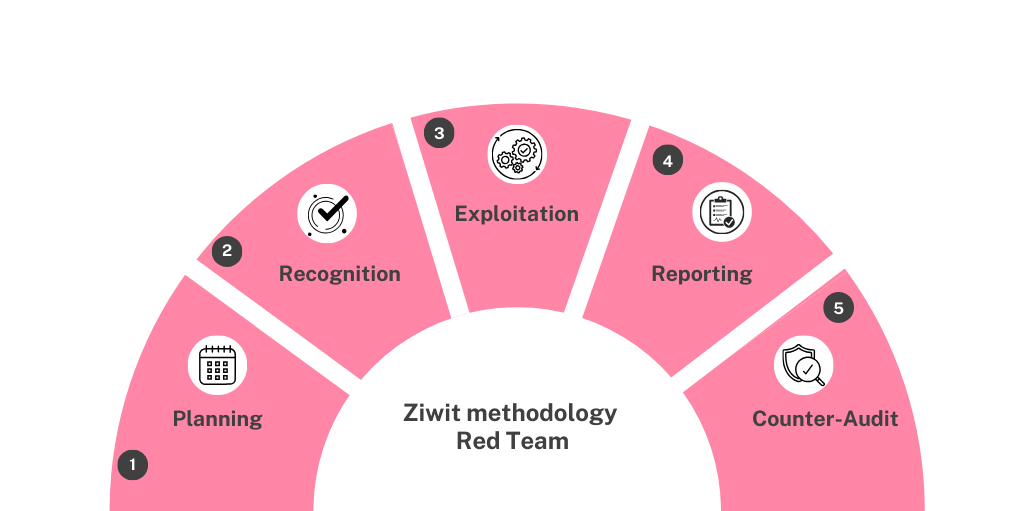The Blue Team is a group of people within an organization responsible for protecting systems against computer attacks. It adapts its methodology according to the threats faced by the organization. It uses tools and technologies to detect security anomalies, prevent intrusions and ensure the protection of the organization's confidential data.
Red Team & Blue Team
The Blue Team and the Red Team are two teams essential to the IT security of a company. They have different goals and roles, but they work together to protect company IT systems from cyberattacks.
The Blue Team is responsible for detecting, preventing and responding to cyberattacks. It uses a variety of tools and techniques to monitor computer systems, identify suspicious activity, and contain attacks.
The Red Team is responsible for simulating attacks against the company. It uses the same techniques as cybercriminals to test company defenses and identify vulnerabilities.
Collaboration between the Blue Team and the Red Team is essential to improve a company's IT security. The Red Team's attacks help the Blue Team identify and fix weaknesses in its defenses, while the Blue Team's responses help the Red Team refine its attacking techniques.
Here are some examples of how the Blue Team and Red Team can work together:
 The Red Team can provide the Blue Team with information on the latest attack techniques.
The Red Team can provide the Blue Team with information on the latest attack techniques.
 The Blue Team can provide the Red Team with information about the company's defenses.
The Blue Team can provide the Red Team with information about the company's defenses.
 Both teams can work together to develop incident response plans.
Both teams can work together to develop incident response plans.
 By working together, the Blue Team and Red Team can create a stronger defense against cyberattacks.
By working together, the Blue Team and Red Team can create a stronger defense against cyberattacks.
 Ziwit Consultancy ServicesManual audits and Pentests on-site or remotely
Ziwit Consultancy ServicesManual audits and Pentests on-site or remotely
 PentestSimulate an IT attack with a penetration test
Security Operations CenterOutsource your IT security with our SOC offer by Ziwit
Phishing CampaignRaise awareness about Phishing and carry out a phishing campaign
PentestSimulate an IT attack with a penetration test
Security Operations CenterOutsource your IT security with our SOC offer by Ziwit
Phishing CampaignRaise awareness about Phishing and carry out a phishing campaign
 Ziwit AcademyTraining, education and best practices in cybersecurity
Incident Response TeamCrisis Unit in case of hacking
Standards & DirectivesZiwit supports you in complying with standards
Outsourced CISO & SupportOutsource your CISO or get support from an expert
RGPD & DPOCheck your GDPR confirmation and your DPO skills
Ziwit AcademyTraining, education and best practices in cybersecurity
Incident Response TeamCrisis Unit in case of hacking
Standards & DirectivesZiwit supports you in complying with standards
Outsourced CISO & SupportOutsource your CISO or get support from an expert
RGPD & DPOCheck your GDPR confirmation and your DPO skills
 PentestSimulate an IT attack with a penetration test
Pentest WebEvaluate the security of your site or web application
Black Box PentestEvaluate the security of your IT system in real conditions
Grey Box PentestIdentify vulnerabilities with limited system knowledge
White Box PentestPerform a penetration test with full access to system information
Internal PentestIdentify security vulnerabilities that can be exploited by an insider attacker
External PentestEvaluate your security by simulating an attack by an external attacker
Pentest as a ServiceProtect yourself continuously and without interruption thanks to our service Pentest as a Service
ISO 27001 PentestPerform an ISO 27001 Pentest
Red TeamImprove your security by identifying your weak points
PentestSimulate an IT attack with a penetration test
Pentest WebEvaluate the security of your site or web application
Black Box PentestEvaluate the security of your IT system in real conditions
Grey Box PentestIdentify vulnerabilities with limited system knowledge
White Box PentestPerform a penetration test with full access to system information
Internal PentestIdentify security vulnerabilities that can be exploited by an insider attacker
External PentestEvaluate your security by simulating an attack by an external attacker
Pentest as a ServiceProtect yourself continuously and without interruption thanks to our service Pentest as a Service
ISO 27001 PentestPerform an ISO 27001 Pentest
Red TeamImprove your security by identifying your weak points




 Define objectives and possible attack scenarios.
Define objectives and possible attack scenarios.  Gather target information to better simulate a real attack.
Gather target information to better simulate a real attack.  Identify potential vulnerabilities in the organization's systems, including possible entry points for an attack.
Identify potential vulnerabilities in the organization's systems, including possible entry points for an attack.  Carry out targeted attacks to identify detected vulnerabilities.
Carry out targeted attacks to identify detected vulnerabilities.  Test the responsiveness and speed of the organization's security systems to identify the ability of security teams to react.
Test the responsiveness and speed of the organization's security systems to identify the ability of security teams to react.  To provide, at the end of the exercise, a detailed and comprehensive report indicating the vulnerabilities identified and recommendations for strengthening the organization's security. Based on the results of the exercise, the organization will be able to improve its security by taking corrective action.
To provide, at the end of the exercise, a detailed and comprehensive report indicating the vulnerabilities identified and recommendations for strengthening the organization's security. Based on the results of the exercise, the organization will be able to improve its security by taking corrective action.  Identify which vulnerabilities are the most critical and should be prioritized for remediation.
Identify which vulnerabilities are the most critical and should be prioritized for remediation. 








